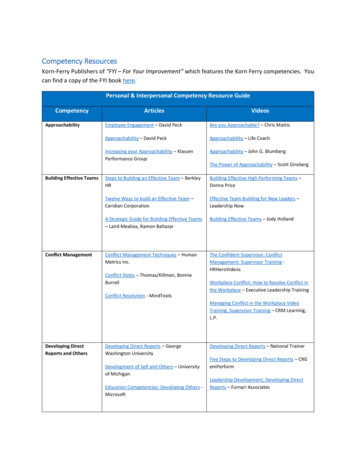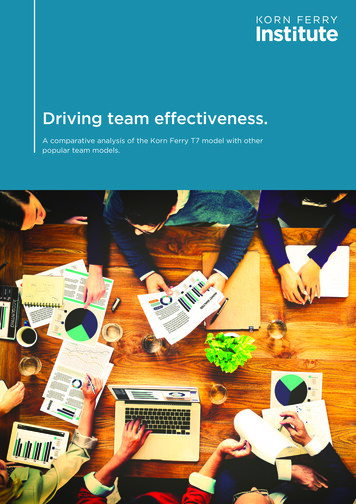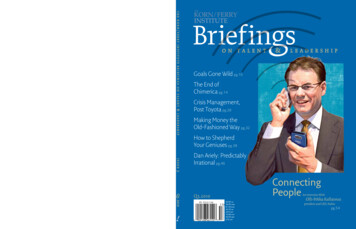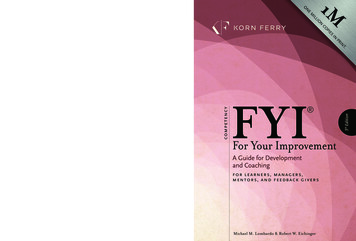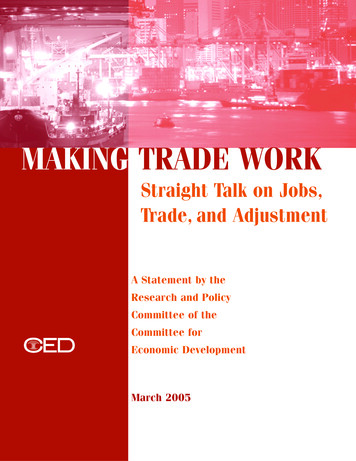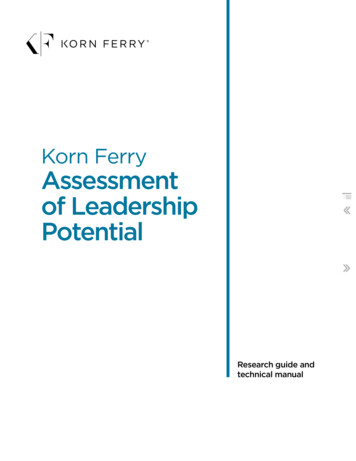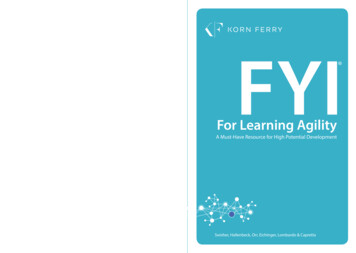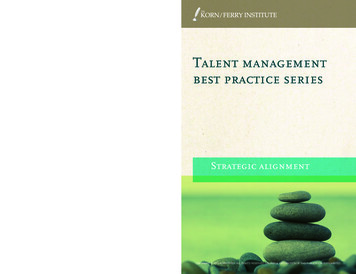
Transcription
The Korn/Ferry Institute generates forwardthinking research and viewpoints that illuminatehow talent advances business strategy. Sinceits founding in 2008, the institute has publishedscores of articles, studies, and books that exploreglobal best practices in organizational leadershipand human capital development.About Korn FerryKorn Ferry is a premier global provider of talentmanagement solutions, with a presencethroughout the Americas, Asia Pacific, Europe,the Middle East and Africa. The firm deliverssolutions and resources that help clients cultivategreatness through the design, building andattraction of their talent.Talent management best practice series: Strategic alignmentAbout the Korn/Ferry InstituteVisit www.kornferry.com for more informationon Korn Ferry, and www.kornferryinstitute.comfor thought leadership, intellectual property,and research.Talent managementbest practice seriesStrategic alignmentThe Korn/Ferry InstituteCOPYRIGHT 2014 KORN FERRY. ALL RIGHTS RESERVED. UNLAWFUL DISTRIBUTION OF THIS PUBLICATION IS PROHIBITED.COPYRIGHT 2014 KORN FERRY. ALL RIGHTS RESERVED. UNLAWFUL DISTRIBUTION OF THIS PUBLICATION IS PROHIBITED.
TALENT MANAGEMENT BEST PRACTICE SERIES: STRATEGIC ALIGNMENTTalent managementbest practice seriesStrategic alignmentCOPYRIGHT 2014 KORN FERRY. ALL RIGHTS RESERVED. UNLAWFUL DISTRIBUTION OF THIS PUBLICATION IS PROHIBITED.
THE KORN FERRY INSTITUTETalent managementbest practice seriesStrategic AlignmentSeries Editor J. Evelyn OrrContributors Guangrong DaiIlene GochmanDavid GrantMichael McGowanDavid McMonagleJ. Evelyn OrrKing Yii TangCopyright 2013 Korn FerryAll rights reservedISBN: 978-0-9885598-7-5www.kornferry.comCOPYRIGHT 2014 KORN FERRY. ALL RIGHTS RESERVED. UNLAWFUL DISTRIBUTION OF THIS PUBLICATION IS PROHIBITED.
TALENT MANAGEMENT BEST PRACTICE SERIES: STRATEGIC ALIGNMENTTable of contentsForeword. . . . . . . . . . . . . . . . . . . . . . . . . . . . . . . . . . . . . . . . . . . . . . . 1Introduction . . . . . . . . . . . . . . . . . . . . . . . . . . . . . . . . . . . . . . . . . . . . . 2The Benefits of Aligning Business and Talent Strategies . . . . . . . . . . . . 6Key Questions to Guide Business and Talent Strategy Alignment. . . . . 81. What is the business context?. . . . . . . . . . . . . . . . . . . . . . . . . 102. What is the business strategy?. . . . . . . . . . . . . . . . . . . . . . . . . 133. What does the organization need to be great at? . . . . . . . . . . 164. What are the talent implications?. . . . . . . . . . . . . . . . . . . . . . . 195. What talent strategy will best enable the business strategy?. . . 276. What HR and talent management practices comprise thetalent strategy? . . . . . . . . . . . . . . . . . . . . . . . . . . . . . . . . . . . . 33Conclusion. . . . . . . . . . . . . . . . . . . . . . . . . . . . . . . . . . . . . . . . . . . . . . 38Appendix A: Business Life Cycle Implications for Talent Strategy . . . . . 40Appendix B: Industry Implications for Talent Strategy . . . . . . . . . . . . . . 42Notes. . . . . . . . . . . . . . . . . . . . . . . . . . . . . . . . . . . . . . . . . . . . . . . . . . 46COPYRIGHT 2014 KORN FERRY. ALL RIGHTS RESERVED. UNLAWFUL DISTRIBUTION OF THIS PUBLICATION IS PROHIBITED.
TALENT MANAGEMENT BEST PRACTICE SERIES: STRATEGIC ALIGNMENTForewordThe Korn Ferry Institute Best Practice Series provides a window into thethought leadership and expertise that Korn Ferry offers as the premierglobal provider of talent management solutions. Each installation of theseries covers a key area of talent management and captures Korn Ferry’sscience, philosophy, and approach. These best practice books provide anintroduction to who Korn Ferry thought leaders are, what Korn Ferry doesbest, and how Korn Ferry can fuel organizations’ success in meeting theirstrategic talent management needs.Korn Ferry’s approach is based on science and informed by what works inpractice. The Korn Ferry Institute Best Practice Series is intended to summarizekey, unique points of view held by Korn Ferry thought leaders that inform ourmethods and approach to strategic talent management. Consider it a way tospark new thinking and get to know what Korn Ferry offers.COPYRIGHT 2014 KORN FERRY. ALL RIGHTS RESERVED. UNLAWFUL DISTRIBUTION OF THIS PUBLICATION IS PROHIBITED.1
THE KORN FERRY INSTITUTE2IntroductionThe 21st century brings a unique and unprecedented set of challenges andpotential opportunities for organizations.The competitive landscape is increasingly global in scope. Today, even small ormidsize companies are challenged to compete on a global scale. The number ofmultinational corporations has doubled since 1990.1 Growth opportunities aremore prevalent in developing regions of the world where the middle class andnew consumers are emerging rapidly. In fact, the global middle class is expectedto grow by 172 percent from 2010 to 2030.2 At the same time, there are shifts inthe available talent pool and workforce demographic. An aging demographicin the West is yielding to higher proportions of college graduates coming fromLatin America, Russia, and Asia. Individuals are being asked to do more withless, but they also have higher expectations for their employers and are moremobile than previous generations. Consumers also have higher expectations,and the companies that make the best use of technology and data analyticsto better understand their customers and break down barriers will win.3,4The pace of market growth, the speed of innovation, and ever-changingdemographics create more opportunities to both create and extract value,but it’s often more difficult to pinpoint those opportunities and act upon them.Top 21st century trends impacting organizations: GlobalizationTechnology and the proliferation of dataEnvironmental concerns and resource constraintsGlobal economyDemographic shiftsHigher expectations of employersConsumer characteristicsCOPYRIGHT 2014 KORN FERRY. ALL RIGHTS RESERVED. UNLAWFUL DISTRIBUTION OF THIS PUBLICATION IS PROHIBITED.
TALENT MANAGEMENT BEST PRACTICE SERIES: STRATEGIC ALIGNMENT3So, how do companies compete in this increasingly complex and changingenvironment? One of the central differentiators for companies is a sound businessstrategy. Leaders who are adept at creating winning strategies make an integratedset of choices regarding issues such as where the business will be active, how toget there, how to win, the specific actions and moves, and the model of profitgeneration.5 A business strategy articulates the direction a business will pursueand the steps it will take to achieve its goals. A good strategy has at least threecharacteristics: it creates value, it’s unique, and it cannot be imitated.6But what’s required for strategic plans to come to fruition? Two things: one,the operations excellence required to execute that enables a company to performbetter and faster than competitors and two, the leadership and talent in place todrive strategy execution.A company may have a very sound strategy on paper, but it’s another thingto bring it to life in the organization. Executing a strategy is just as important,if not more so, than formulating strategy.7 Arguably, people are one of the mostimportant ways a company unlocks its strategy. Talented people are the fuel toget things done in an organization and can be a key competitive asset. Managingthose people is critical to achieving business strategy. Essentially, a company gainscompetitive advantage when it delivers distinct products and services throughdistinct human resources.In most organizations, including large ones such as the Fortune 500, total humancapital costs account for as much as nearly 70 percent of operating expense.8Logic tells us that people make or break an organization because all decisionsand actions depend on the capabilities and coordination of people.With human capital being such a key asset in driving business strategy, it’simperative for companies to have a well thought-out talent strategy. In otherwords, companies need to deliberately set priorities and take actions thatactivate the business strategy and drive operations excellence by developing andsustaining a pipeline of the right leaders, with the right abilities, in the rightroles, at the right times.In Korn Ferry’s view, close alignment of a company’s business and talentstrategies helps ensure the realization of both the business strategy and theoperations excellence required to deliver expected outcomes.COPYRIGHT 2014 KORN FERRY. ALL RIGHTS RESERVED. UNLAWFUL DISTRIBUTION OF THIS PUBLICATION IS PROHIBITED.
THE KORN FERRY INSTITUTE4Two Key Elements of AlignmentStrategic talent management consists of two key elements —vertical alignment and horizontal alignment.9Vertical alignment (what we think of as strategic alignment) refers tothe linkage between business needs and individual performance.The guiding logic is that a firm’s human resource management practicesmust develop individuals’ skills, knowledge, and motivation such thatthey behave in ways that are instrumental to the implementation ofa particular strategy. In other words, business strategies define therequired role behaviors. Human resource management should bepracticed in a way to staff the workforce and foster such role behaviors.Consequently, business strategies determine which roles providecompetitive advantage, the type of talent required, and the type ofbehaviors to be cultivated and rewarded.Horizontal alignment (what we think of as integrated talentmanagement) refers to the extent to which different HR practicesare integrated to serve the same human resource managementgoals. Human resource management is seen as a coherent system.Combinations of HR practices, or HR bundles, have bigger effects onindividual behaviors than the sum of the component impacts due toindividual practices. The key issue here is not about maximizing theeffects of individual HR practices, but achieving optimization amongthem. For instance, depending on the specific configurations, heavyinvestment in employment engagement may be appropriate in onecompany, but maintaining a healthy in-and-out flow of talent maybe appropriate in another.The distinction between vertical alignment and horizontal alignmentresonates with Boudreau and Ramstad’s (2007) articulation on thedifferences among HR impact, effectiveness, and efficiency.10 The issueof impact concerns the relationship between talent management andbusiness outcomes. Different types of talent have different strategicvalues.11 Investment on the strategically important part of the talentspace generates exceptional return. Therefore, impact analysis helpsstrategically prioritize and focus the efforts of talent management.Once the direction and talent management goal has been determined,the HR systems can be designed and implemented according to twomeasures of HR process: effectiveness and efficiency.COPYRIGHT 2014 KORN FERRY. ALL RIGHTS RESERVED. UNLAWFUL DISTRIBUTION OF THIS PUBLICATION IS PROHIBITED.
TALENT MANAGEMENT BEST PRACTICE SERIES: STRATEGIC ALIGNMENTCOPYRIGHT 2014 KORN FERRY. ALL RIGHTS RESERVED. UNLAWFUL DISTRIBUTION OF THIS PUBLICATION IS PROHIBITED.5
THE KORN FERRY INSTITUTE6The Benefits of AligningBusiness and Talent StrategiesWhen a company aligns its talent strategy to its business strategy, it is morelikely to achieve its strategic objectives, perform better in the market,and retain highly engaged, high-performing individuals. The benefitsof strategic talent management are well documented in the literaturethat spans over two decades of research with different types of organizationsin diverse industries and regions.Research on the impact of strategic talent management on both companyand individual performance helps quantify the value of aligning business andtalent strategy. The magnitude of the return on investment from aligningand integrating HR practices is substantial. One seminal study found that aone standard deviation increase in investment in aligning and integrating HRpractices is associated with a 7.5 percent decrease in employee turnover and,on a per employee basis, 27,044 more in sales, 18,641 more in market value,and 3,814 more in profit.12Additional studies show that when companies align talent strategy withbusiness strategy, there are clear positive results: A boost in morale13 Increased productivity12, 14 Increased discretionary effort15 Lower turnover12, 16 Higher customer satisfaction14 Improved process and machine efficiency14 Enhanced ability to be innovative across the company15 Better company financial performance12, 13, 15COPYRIGHT 2014 KORN FERRY. ALL RIGHTS RESERVED. UNLAWFUL DISTRIBUTION OF THIS PUBLICATION IS PROHIBITED.
TALENT MANAGEMENT BEST PRACTICE SERIES: STRATEGIC ALIGNMENTTo reap these business benefits, there are a few critical success factors.A company’s business strategy must be sound and its talent strategy mustbe designed to support the business strategy and integrated across all humanresource practices. Although it’s helpful for the talent strategy to be basedon best practices, research has found that aligning HR practices to businessstrategy had a stronger impact than best practices in achieving positiveoutcomes.17, 18, 19Guiding Principles for Aligning Talent Strategyto Business StrategyStrategic alignment does not mean talent strategy has to imitatebusiness strategy. Too often people confuse “alignment” with “reflect”or “be similar.” The logic goes that if the business strategy is todrive innovation, HR must be innovative. It only makes sense, right?Not necessarily. In this case, HR needs to provide the talent that candrive innovation where it is needed. Talent strategy doesn’t need tobe a reflection of the business strategy; it needs to support andprovide the talent resources that will make the strategy successful.One size does not fit all. There are many ways of going aboutaligning talent strategy to business strategy. And there are manypractices for managing talent. Trying to find the one-size-fits-allbest practice is misguided. Tailoring HR and talent managementpractices to a company’s specific context involves paying attentionto industry, business life cycle, and strategic direction considerations.In fact, research shows that alignment is more important thanfollowing established best practices.19Invest in different roles differently. All roles are important to thesuccess of an organization. However, some roles contribute totable stakes whereas others affect the success of specific businessstrategies. Segmenting talent and applying specific talent managementpractices to those differentiated segments yields a greater returnon investment.COPYRIGHT 2014 KORN FERRY. ALL RIGHTS RESERVED. UNLAWFUL DISTRIBUTION OF THIS PUBLICATION IS PROHIBITED.7
8THE KORN FERRY INSTITUTEKey Questions to GuideBusiness and Talent StrategyAlignmentAligning business and talent strategies requires some careful analysis.Because everything exists as a nested part of a larger context, it’s importantto get a broad perspective of the business landscape. Understanding externalbusiness issues such as 21st century trends, economic realities, and industrycontext can provide a useful backdrop for the business strategy. The next step isto gain an understanding of the strategic intent for the organization. Given theincreased size and complexity of companies today, one might find multiple andpossibly competing business strategies when surveying the enterprise.From the business strategy, it’s important to understand what the organizationneeds to excel at in order to deliver on the strategy. From there, it is helpful todetermine what talent is needed to shape, advance, and execute the strategysuccessfully. Taking into consideration what talent is required versus whattalent is available, what the pivotal roles are, and an analysis of where talentcould be a constraint on the business, the final steps involve creating analigned talent strategy and designing practices for managing that talent.It’s important to keep in mind that there are no right answers. Best practicesin talent strategy are dependent on the context of the business. For anyorganization, what works best is contingent upon the situation and the strategy.For this reason, the strategic alignment process is a process of discovery that isunique for every organization.COPYRIGHT 2014 KORN FERRY. ALL RIGHTS RESERVED. UNLAWFUL DISTRIBUTION OF THIS PUBLICATION IS PROHIBITED.
TALENT MANAGEMENT BEST PRACTICE SERIES: STRATEGIC ALIGNMENTBusiness Strategy and Talent Strategy Alignment Process 1. Survey the business context.2. Understand the business strategy.3. Identify organizational capabilities.4. Determine talent implications.5. Create an aligned talent strategy.6. Design HR and talent management practices.COPYRIGHT 2014 KORN FERRY. ALL RIGHTS RESERVED. UNLAWFUL DISTRIBUTION OF THIS PUBLICATION IS PROHIBITED.9
10THE KORN FERRY INSTITUTE1. What is the business context?The business context consists of elements outside the boundary of theorganization that have the potential to affect all or part of the enterprise.Often referred to as the PEST analysis, these elements fall into several broadcategories including political, economic, social, and technological.20 It’simportant to understand the external conditions affecting everyone as wellas how they might influence a particular company differently from the rest ofthe competition. Consider the 21st century trends and forces that are creatingopportunities and threats in the marketplace. Review the patterns and realitiesthat affect the organization’s ability to compete. What’s going on in the economy that is affecting everyone? Does it affect the competitors differently? Do some organizations have a differentiated advantage? Why? What industry trends are emerging (e.g., increased regulation)? How are these industry trends influencing different companies? Do these trends help or hurt some organizations more than others? What assumptions are being made about where the industry is going? Where are competitor organizations placing their bets? Is the business context relatively complex or stable?COPYRIGHT 2014 KORN FERRY. ALL RIGHTS RESERVED. UNLAWFUL DISTRIBUTION OF THIS PUBLICATION IS PROHIBITED.
TALENT MANAGEMENT BEST PRACTICE SERIES: STRATEGIC ALIGNMENT11Consider whether the business context involves Scarce supply of raw materialsGlobal marketUncertain or unpredictable environmentUnpredictable trendsCustomized products or servicesHigh level of customer responsivenessPotential risk for disruptive innovationPlentiful supply of raw materialsDomestic marketPredictable, stable environmentPredictable trendsStandardized products or servicesLower level of customer responsivenessLess risk for disruptive innovationThen the business environment iscomplex and changing.Then the business environment is morestable and consistent.A complex and changing businessenvironment requires a nimble,flexible approach to talent.A stable and consistent businessenvironment requires a more consistentand systematic approach to talent.For example, the boom and bust cyclein the oil industry coupled with thecomplex business environment havecreated a need for creative solutions toaddress the scarce supply of geologistsand petroleum engineers to grow thebusiness. In fact, the business contextthat created a scarcity of key talentcaused the industry to reach out touniversities to create petroleumengineering programs.For example, regional utilities typicallyhave steady demand and manage theirsupply carefully, and the talent requiredto deliver services is consistentand reliable.Note: Both realities may be present in different business units of the same company.COPYRIGHT 2014 KORN FERRY. ALL RIGHTS RESERVED. UNLAWFUL DISTRIBUTION OF THIS PUBLICATION IS PROHIBITED.
12THE KORN FERRY INSTITUTEAnalyzing the broader context provides valuable insight into the viability of anorganization’s strategic intent — how it intends to win in the market. It’s importantto keep in mind that business context can change quickly. For example, agriculturalcompanies that invested in decades of R&D related to GMOs suddenly find theirproducts shut out of Europe. Another example is the health care industry in whichnew health laws affect how companies can operate. A meaningful analysis of thesechanges to the business context includes asking a couple of key questions: How doesthe context differentially affect our company versus our competitors? How willour company take advantage of the change in business context? After surveyingthe strategic context, it’s helpful to gain a more detailed understanding of thebusiness strategy.COPYRIGHT 2014 KORN FERRY. ALL RIGHTS RESERVED. UNLAWFUL DISTRIBUTION OF THIS PUBLICATION IS PROHIBITED.
TALENT MANAGEMENT BEST PRACTICE SERIES: STRATEGIC ALIGNMENT132. What is the business strategy?People can be overwhelmed by the long list of strategies organizations canadopt — customer intimacy, innovation, organic growth, M&A, cost leadership,globalization, corporate partnership, etc. These espoused strategies tend toaddress one or a few of the elements of a coherent strategy that organizationsneed to have. A coherent strategy consists of an integrated set of choicesregarding five strategic decisions:5 W here the business will be active. It is the decision about the productcategories, market segments, or geographic areas that the organizationwill focus on. A globalization strategy implies an expansion into newgeographic areas. H ow to get there. This element defines the means for attaining the neededpresence in the area the organization wants to be active. Internal productdevelopment, M&A, corporate partnership, and franchising are some of thegrowth models. A company that wants to globalize its business can do sothrough approaches such as M&A, joint venture, or fully-owned investment. H ow to win in the marketplace. It is about the unique value proposition thatdifferentiates the company from others. It doesn’t mean the company has to beat the extreme on any differentiating dimensions; rather, it is the appropriatecombination of several differentiators that forms a competitive advantage. W hat the sequence of moves are and when. The achievement of ultimatestrategic objectives may require a sequence of moves. Some initiatives mustcome first, followed only then by others. For instance, a company that wantsto enter a foreign market may want to establish joint ventures with localfirms to learn the know-how of doing business in the local market beforefully investing in it.COPYRIGHT 2014 KORN FERRY. ALL RIGHTS RESERVED. UNLAWFUL DISTRIBUTION OF THIS PUBLICATION IS PROHIBITED.
14THE KORN FERRY INSTITUTE H ow profits will be generated. It is about the model of profit generation thatis established on a central economic logic. Whether to charge customersat the premium prices or to use price as leverage, the economic logicsare rooted in the organization’s fundamental and relatively enduringcapabilities. For instance, a company can sell a device at a very competitiveprice, but generate much of the profits from the services that are deliveredduring the usage of the device by the customers.For example, one global retailer that has opted for a strategy of cost leadershipcompetes based on scale rather than quality. The targeted customer market,the global sourcing strategy, an efficient supply chain management, and lowcost labor are all components of the strategy that enable this company to winthrough cost leadership.Even within the same industry, similar business contexts do not yield the samestrategy and the same talent strategy. One variable is how different companiesunderstand the future of the industry and business context. For example,two companies that engineer and manufacture airplanes placed their bets verydifferently. Company A decided that the future of air travel was in the hub andspoke model and that large planes would be in demand by airline companies.Company B decided that the future of air travel would be more focused on quick,efficient, and direct routes and so it built a smaller and more efficient airplane.Depending on how the future actually unfolds, companies may need to changecourse quickly to compete.Another variable that yields different strategies within the same business contextinvolves companies that redefine the value proposition for customers andhow they make money. For example, established airline companies focusedCOPYRIGHT 2014 KORN FERRY. ALL RIGHTS RESERVED. UNLAWFUL DISTRIBUTION OF THIS PUBLICATION IS PROHIBITED.
TALENT MANAGEMENT BEST PRACTICE SERIES: STRATEGIC ALIGNMENT15on monopolizing key hubs, whereas latecomer airlines needed to compete ona different front. One small and upcoming airline that got locked out of thebest terminals and had to contend with many fewer gates chose to compete byincreasing the turnover of flights from those gates. Using NASCAR pit crews asa model, it focused on building its ground operations talent as a competitivedifferentiator.It’s critical to understand how an organization intends to compete and whatstrategic resources and processes will be the basis for winning with thosestrategies. Competitive strategy is about being different; it rests on uniqueactivities.6 Sustained competitive advantage should be established on resourcesthat are valuable, rare, inimitable, and nonsubstitutable.21 Most strategies arebased on either growth or operational efficiency. Either approach is aimed atimproving margin and increasing return on investment. W hat product categories, market segments, or geographic areas will theorganization focus on? What are the strategic objectives and the plans for achieving them? How does the organization differentiate itself from its competitors? What is the unique value proposition? hat needs to happen first, second, and so on for the organization to move Wtoward achieving its strategic objectives? How will profits be generated?COPYRIGHT 2014 KORN FERRY. ALL RIGHTS RESERVED. UNLAWFUL DISTRIBUTION OF THIS PUBLICATION IS PROHIBITED.
16THE KORN FERRY INSTITUTE3.What does the organization need to be great at?Knowing what an organization needs to excel at in order to achieve the businessstrategy is a key bridge to talent strategy.22 Organizational capabilities or “corecompetencies” provide one approach to bridge business strategies with successprofiles for specific roles or individuals.23Every business strategy (e.g., expanding sales channels, growing in new emergingmarkets) has clear implications for the organizational capabilities an enterpriseneeds for those strategies to be successful. Explore the implications of thosestrategies as well as focus efforts on those areas in which a lack of capabilitieswill put the business strategy at risk. What strategic capabilities are unique to the organization or to competitors? What are the critical business processes? Where are there constraints inthose processes? What does the organization need to excel at to meet its strategic objectives? What can the organization be the best at?One way to achieve more sustainable competitive advantages is by establishingand managing a portfolio of core organizational competencies rather thana portfolio of businesses.23 Corporate core competencies are the collectivelearning in the organization and reflect its combined capabilities. For instance,some companies are good at innovation, some are good at managing the valuechain, and others are good at operational efficiency or managing customerrelationships. When the business strategy is supported by the organizationalcapabilities, the enterprise is more likely to sustain its competitive advantage.COPYRIGHT 2014 KORN FERRY. ALL RIGHTS RESERVED. UNLAWFUL DISTRIBUTION OF THIS PUBLICATION IS PROHIBITED.
TALENT MANAGEMENT BEST PRACTICE SERIES: STRATEGIC ALIGNMENT17Korn Ferry’s organizational capability model includestwenty-one dimensions organized under six factors:1. L eadership Effectiveness — Effective board governance,executive leadership team effectiveness, and the ability tolead change and transform an organization.2. T alent Strategy and Management — The ability to acquire,develop, engage, and deploy talent.3. I nnovation — Product, service, and business model innovationas well as an environment that encourages some experimentation.4. F ocusing on the Customer — Strong connection to customers,understanding customer needs and behaviors, cultivating acompelling value proposition.5. P roductive Organizational Culture — Fostering a shared mindset,a climate of openness, and a commitment to collaboration.6. S trategy Execution — Promoting operational excellence throughorganizational design, leveraging key functional areas, cleardecision making and processes.The establishment of organizational capabilities or core competencies dependson individual skills, knowledge, and abilities.24 Corporate core competencies areformed when individual skills, knowledge, and abilities are widely shared acrosseveryone in an organization. Fundamentally, corporate core competencies arereflected in human capital and institutionalized in organizations throughstrategic talent management practices.25Organizational capabilities or corporate core competencies are often translatedinto individual competencies through the practice of competency modeling.Like organizational capabilities, when the competency modeling processincludes a substantial effort to understand an organization’s business contex
strategic talent management needs. Korn Ferry's approach is based on science and informed by what works in practice. The Korn Ferry Institute Best Practice Series is intended to summarize key, unique points of view held by Korn Ferry thought leaders that inform our methods and approach to strategic talent management. Consider it a way to

